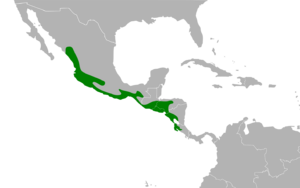Lesser ground cuckoo facts for kids
Quick facts for kids Lesser ground cuckoo |
|
|---|---|
 |
|
| Conservation status | |
| Scientific classification | |
| Genus: |
Morococcyx
|
| Species: |
erythropygus
|
 |
|
The lesser ground cuckoo (Morococcyx erythropygus) is a special type of cuckoo bird. You can find it in countries like Costa Rica, El Salvador, Guatemala, Honduras, Mexico, and Nicaragua. This bird spends most of its time on the ground.
Contents
About the Lesser Ground Cuckoo
The lesser ground cuckoo is the only bird in its group, called a genus. It has two main types, known as subspecies. These are M. e. erythropygus and M. e. mexicanus. Subspecies are like different versions of the same animal that live in different places and have slight differences.
What Does the Lesser Ground Cuckoo Look Like?
This cuckoo is about 25 to 28 centimeters (10 to 11 inches) long. Males usually weigh around 58 to 66 grams (2 to 2.3 ounces), and females are a bit heavier, from 56 to 76 grams (2 to 2.7 ounces). Females look a little lighter in color than males, but they are mostly the same.
Their beak is slightly curved. The top part is blackish-brown, and the bottom part is orange. Their face has cool patterns! They have a bright yellow ring around their eye, with bare blue skin behind it. Thin black lines surround this area. They also have a faint whitish stripe above their eye and cinnamon-colored cheeks.
Adults of the main type (M. e. erythropygus) have a grayish-brown head, an olive-brown neck and back, and a dark lower back. Their tail is mostly olive-brown with a shiny purplish-bronze look. The tips of their tail feathers are buff or whitish. The underside of their tail is light grayish-brown with dark bands near the ends of the outer feathers. Their belly and chest are a cinnamon-orange color. Young birds look similar but are duller and don't have the pale tips or dark bands on their tails.
The other type, M. e. mexicanus, is larger and paler. Their upper parts are grayer, and their underparts are more buff or pale yellow. However, the underside of their tail is darker.
Where Does the Lesser Ground Cuckoo Live?
The main type of lesser ground cuckoo (M. e. erythropygus) lives from southern Mexico all the way south through Guatemala, El Salvador, Honduras, and Nicaragua into Costa Rica. The M. e. mexicanus subspecies is found on the Pacific side of western Mexico.
These birds like dry or semi-dry places. You can find them inside or at the edges of woodlands, in thorn forests (which have lots of thorny bushes), in secondary forests (forests that have grown back after being cut down), and in savannas (grassy plains with scattered trees). In southwestern Mexico, they mostly live in thorn forests.
How Does the Lesser Ground Cuckoo Behave?
Movement
The lesser ground cuckoo stays in the same area all year round. It does not migrate to other places.
Feeding Habits
This cuckoo mainly eats insects. It catches them by walking on the ground or by making short jumps to pick them off plants. We don't know all the details about what else it eats, but insects are a big part of its diet.
Reproduction
The breeding season for the lesser ground cuckoo changes depending on where they live. In Costa Rica, they breed between February and May. In Mexico, they seem to breed in May and June.
They build a simple, shallow nest on the ground using sticks or leaves. Both the male and female birds take turns sitting on the eggs. They usually lay two eggs. We don't know exactly how long it takes for the eggs to hatch or for the young birds to be ready to fly.
Vocalization
The lesser ground cuckoo has a very interesting song! People have described it as a series of 10 or more loud, rolling or trilling notes. It often starts with 2 or 3 clear, rising whistles. Some say it sounds like loud, rich, rolled whistles, almost like a referee's whistle: prree,...prree,....prree, prree-prree-prreeprree ... prree, prree, prree,....prree,.........prree. It also makes a clear whistle sound, teeeee, and a rough, growling sound, ghaaaoow.
What is the Lesser Ground Cuckoo's Conservation Status?
The IUCN (International Union for Conservation of Nature) has looked at the lesser ground cuckoo and decided it is a species of "Least Concern." This means that it is not currently in danger of disappearing.
It lives across a very large area. Experts believe there are between 50,000 and 500,000 adult birds, but this number might be slowly going down. Even so, there are no big, immediate threats that could harm the species right now.


